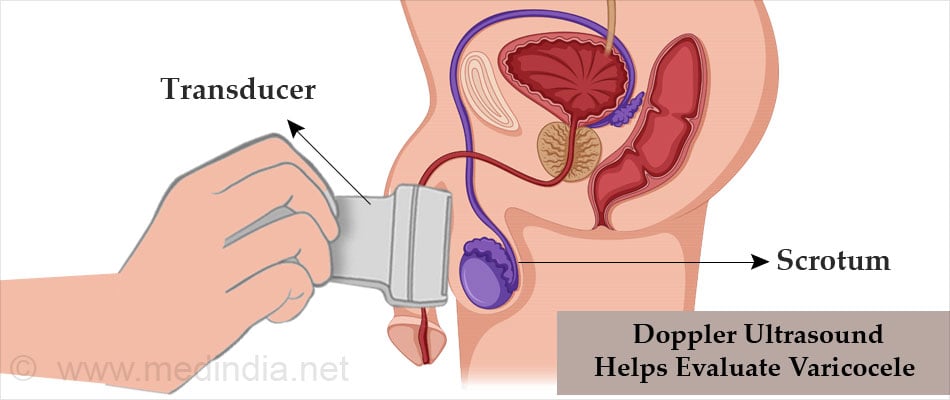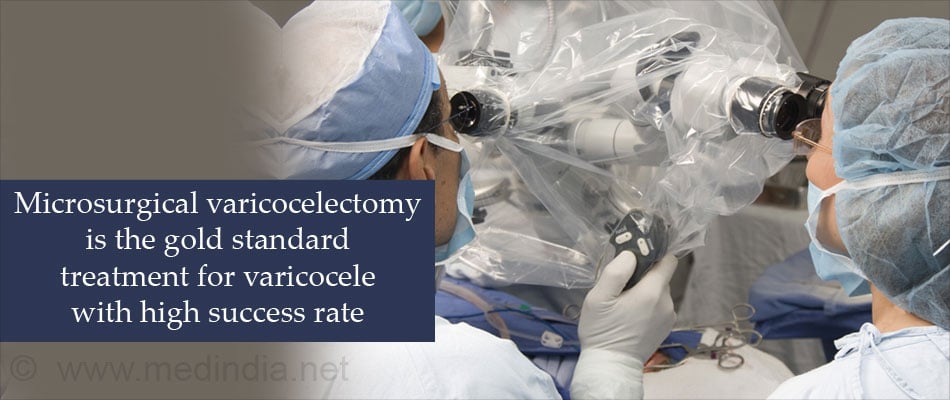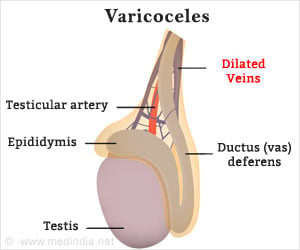What is Varicocelectomy?
Varicocelectomy is a surgical procedure performed to treat a condition called varicocele in males. In this condition, the veins draining the testicles become enlarged and tortuous and are visible on the surface of the scrotal skin. Around 10-15 percent men are affected by this condition which is sometimes associated with a decreased sperm count and infertility. Varicocele usually affects men between 15 to 25 years of age, though it may occur at an older age as well.

Most patients with varicocele are asymptomatic but some may present with swelling, discomfort and dull pain. Varicocele is also found to be associated with infertility.
Anatomy
The testes are drained by a network of veins known as the pampiniform venous plexus. These veins drain into the left spermatic vein on the left side and the right spermatic vein on the right side. The left spermatic vein opens up into the left renal vein, while the right spermatic vein opens up into the inferior vena cava. These veins travel through the spermatic cord and cool the blood passing through the testicular artery. The veins are normally not palpable. When they enlarge, they become noticeable and palpable as a lump in the scrotal sac. The swelling is often compared to ‘a bag of worms’ due to its appearance.
What are the Indications for Varicocelectomy Surgery?
Varicocelectomy involves ligation of the spermatic veins. A varicocele may require surgery if it is associated with any of the following:
- Small size of the gonads or slow testicular growth in children or teens
- Pain in the scrotum
- Aesthetic problems
- Presence of infertility due to the varicocele

What are the Types of Varicocelectomy Surgery?
Types of varicocelectomy surgery include the following:
- Open varicocelectomy, which involves an open surgery. Depending on the location of the incision, this type of surgery can be divided into the following types:
- Retroperitoneal high ligation, where the incision is taken in the lower abdomen
- Inguinal ligation
- Sub-inguinal ligation. In inguinal and sub-inguinal ligation, the incision is taken in the groin.
- Laparoscopic varicocelectomy, which uses a telescope-type instrument called laparoscope
- Microsurgical varicocelectomy, which uses an operating microscope and microsurgical instruments

What are the Tests done before a Varicocelectomy Surgery?
Tests done before a varicocelectomy procedure include the following:
Routine tests:
Routine tests which are done before any surgery include:
- Blood tests like hemoglobin levels, blood group, liver and kidney function tests
- Urine tests
- ECG (Electrocardiogram) to study the electrical activity of the heart
- Chest X-ray
In older patients, a detailed assessment of the heart may be required to make sure that they are fit for surgery.
Tests to evaluate the varicocele:
A physical examination may be sufficient to diagnose a varicocele. A varicocele is difficult to palpate in the lying position and therefore the doctor examines the patient in the standing position.
The varicocele may be categorized as follows:
Grade 1- The varicocele is palpable only during Valsalva maneuver. Valsava maneuvre is performed by asking the patient to breath out forcefully with mouth and nostrils closed.
Grade 2- Varicocele is palpable on inspection in the standing posture without the Valsalva maneuver.
Grade 3- Varicocele is palpable and visible in all postures and positions.
Ultrasound / Doppler of the scrotum: An ultrasound / Doppler of the scrotum is usually done to know the extent of dilatation of the veins in order to decide the course of treatment. During the procedure, a gel will be applied to the skin over the area to be examined. A probe will be run over the skin and images obtained are visualized on a screen. Ultrasound for varicocele is obtained in the standing position and during Valsava manoeuvre.

Angiography: Angiography is a procedure where a dye is injected into blood vessels and radiological imaging is conducted. It is used to study the abnormal blood vessels in the varicocele.
CT scan / MRI scan: A CT scan or an MRI are imaging tests that may be used to evaluate the varicocele. You will be asked to lie on a table while images are taken. For an MRI, the table will enter a tunnel. You may receive an injection containing a dye into a vein for better images.
How is Varicocelectomy Performed?
Type of Anesthesia – Varicocele surgery is done either under general anesthesia or spinal anesthesia. In some cases, local anesthesia may also be used. If you undergo general anesthesia, you will be asleep during the procedure and will not be aware of what is going on. Under spinal or local anesthesia, you will be awake but will not be able to feel any pain during the surgery. Laparoscopic surgery is done under general anesthesia.
Pre-operative Check-up – Routine tests as indicated above are ordered a few days before the surgery. Admission may be required a day before the surgery.
Fasting before Surgery - Overnight fasting is required if you are undergoing the surgery under general anesthesia and occasionally intravenous fluid maybe required to keep you well hydrated. Sedation is sometimes required for good overnight sleep before the surgery.
Shift from the Ward or Room to the Waiting area in the Operating room - An hour or two before the surgery, you will be shifted to the operating room waiting area on a trolley. Once the surgical room is ready, you will be shifted to the operating room.
Shift to the Operating room - The ambience in the operating room can sometimes be very daunting and a small amount of sedation can help overcome your anxiety. From the trolley, you will be shifted on to the operating table. As you look up, you will see the operating light console and at the head end will be the anesthesia machine. There may also be monitors to check oxygen levels, ECG and other vital parameters. A constant beeping sound may be present from the monitors, which may sometimes be irritating.
Anesthesia before Surgery – If you are undergoing general anesthesia, the anesthetist will inject drugs through an intravenous line and make you inhale some gases through a mask that will put you in deep sleep. Once you are asleep, a tube will be inserted into your mouth and windpipe to administer the anesthesic gases to overcome pain and keep you comfortable while the surgery is going on. If you are administered spinal anesthesia, you will receive an injection in your lower back, following which your lower body will feel numb. For local anesthesia, you will receive injections in the area that is to be operated.
Varicocelectomy Procedure
The position of the incision for the surgery depends on the type of open surgery. In high retroperitoneal ligation, a horizontal incision is made in the lower abdomen on the same side of the surgery. In inguinal and subinguinal ligation, the incision is made in the groin. The underlying muscles are then separated and the spermatic cord is identified. An incision is made on the spermatic cord to expose the dilated veins which are ligated. Care is taken to preserve the testicular artery and the lymphatics during the procedure.
Microsurgery with the help of an operating microscope can be done under local, regional or general anesthesia. The side effects following the procedure are reduced due to accurate identification of arteries and lymphatics during the surgery.

Waking up from General Anesthesia – If you have received general anesthesia, once the surgery is over, you will wake up and the tube down the wind pipe will be removed. You will be asked to open your eyes before the tube is removed. You will be sedated and the voice of the anesthetist may be faint. Once the tube is out, you may have cough and sometimes nausea. Once fully awake, you will be shifted on the trolley and taken to the recovery room.
Recovery room – In the recovery room, a nurse will monitor your vitals and observe you for an hour or two before shifting you to the room or a ward.
Post-operative recovery – You may remain in the hospital for a day following the surgery. You will receive painkillers. An ice pack may need to be kept on the area in the initial 24 hours to reduce the swelling.
DVT Prophylaxis – Early movement of your legs and some mobilization prevents DVT or deep vein thrombosis, where a clot is formed in the deep veins of the legs. The clot can travel up to the lungs and even be fatal. Pain relievers may be prescribed depending on the extent of the pain.
Advice following Discharge - Care must be taken to keep the incision site dry and look out for any signs of infection. You may be instructed by the treating doctor to wear a snug underwear or an athletic support for 2 weeks after the surgery. You can resume work in a couple of days as long as it does not require any heavy physical activity. It is best to avoid strenuous activity for 3 weeks after the surgery. It is important to go for regular follow-ups as instructed by the doctor.
What are the Complications of Varicocelectomy?
Although varicocelectomy is a relatively safe procedure, it may result in a few complications.
Complications of the procedure include the following:
- Accidental testicular artery ligation or injury
- Injury to the genitofemoral nerve
- Formation of hydrocele due to accidental ligation of lymphatics
- Air embolism during laparoscopic surgery
- Rarely Peritonitis
- Injury to the intestines
- Persistence or recurrence of the varicocele
- Atrophy of the testis
- Injury to the vas deferens
- Wound infection
- Formation of a blood clot (hematoma)







